The Puzzle Pieces
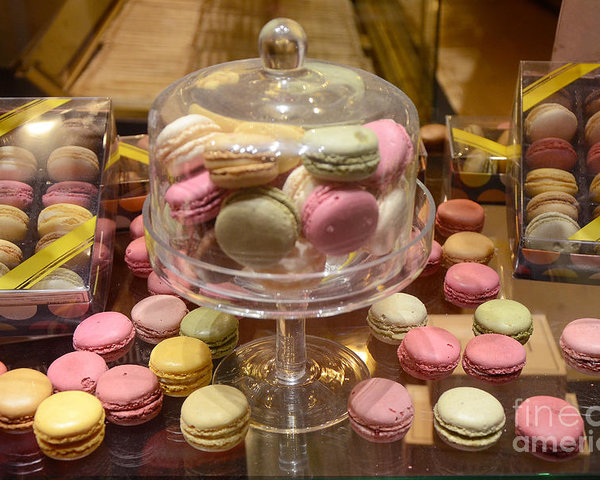 I find it very interesting, how I’ll be walking down the street and see a bakery that’s selling macaroons, and a memory of eating a vanilla macaroon in Europe pops in my head that very moment. I immediately snap into this memory, not conscious of what’s happening around my surroundings in the present. Memories that I have are embedded in objects, places, people which I didn’t realize before. I feel like we all had this moment but didn’t assess the moment and reason why our mind averted to that certain memory at that time.
I find it very interesting, how I’ll be walking down the street and see a bakery that’s selling macaroons, and a memory of eating a vanilla macaroon in Europe pops in my head that very moment. I immediately snap into this memory, not conscious of what’s happening around my surroundings in the present. Memories that I have are embedded in objects, places, people which I didn’t realize before. I feel like we all had this moment but didn’t assess the moment and reason why our mind averted to that certain memory at that time.

I didn’t notice this style of representation of memory until I read a book in my ASTU class. In my class, we were assigned to read a feminist book called Basic Black with Pearls, by Helen Weinzweig which shows the life of Shirley Kaszenbowski who has an affair with a spy named Coenraad. From cracking secret codes, she concludes that her next meet up with Coneraad is in Toronto, which happens to be where she is originally from. In Toronto, she embarks a series of memories of her past and develops relationships with people and develops worlds for them. At first, I didn’t like the book as I found it hard to accustom to the style of reading with it’s style of interpretation. However, page after page, I got accustomed to this style and I was very intrigued in the story. It is very evident throughout the book, that her life is revolved around Coenraad, which I find very frustrating because she doesn’t have a life of her own. As a feminist, I wanted Shirley to find her own self and not limit herself due to her lover, as she is facing more consequences than him. Although, at the end of the book I found the ending to be pleasing as it shows independence and the realization of self identity.
Toronto is seen as this explosive device of memory where her past is seen through her and is evident as it cannot be hidden through her black dress and pearls. An example of this is when she buys rolls at a store, but also orders Russian black bread which signifies her class. Even though she is dressed very proper which show she is upper class, the choice of bread shows how her roots which is the lower class. In my last blog, I talked about the character Nick and the significance of the swamp which was in Big Two Hearted River, written by Ernest Hemingway. Her connection with Toronto is the same as Nick’s with the swamp, both places hold memories, repressed feelings, and feel like trauma which they have to get away from. If you have no idea about what I mean about Nick and the swamp, check out my last blog which is fantastic and it will all make sense.
The memories of Toronto make her so mad as she believes she is suffering from the “blows of memory” and she imposes that if Coenraad appears she won’t be in a good mood (Weinzweig, 53). I find this quite intriguing as the memories in the city cause her so much trauma that it affects her mood towards her lover who she has an obsession with. In the novel, she confesses at one point that the reminiscing of the old streets cause her to lose focus on finding Coenraad in his disguise. These memories are so strong that it alters her perspective and her thoughts. A good example of these flashes of memories is when she looks at the City Hall tower and a “flow of images” releases of the details inside juvenile court and her mother crying (Weinzweig, 31). Just like my experience with the bakery, Shirley snaps into the past in the present just by looking at the tower. Memory is also represented through looking at postcards as it feels more colourful and sensational than the actual event. Shirley is seen as very odd as she hears background noise and smells certain scents all while looking at a certain pictures on the postcards.
Shirley or Lola as she goes by is also a spy like her lover as she disguises herself with her black dress and pearls. This image of her signifies that she is upper class and proper which convinces the people around her like the customs as she is seen as a safe women. In a sense, she is presenting herself in a veiled self which becomes unveiled in the end when she trades her black dress for a multicolour dress. This book is like a spy movie as there is a mask that is taken off, but in terms of the book, it is the protagonist mask that is being unveiled. At the end of the book, the exchange of dresses shows the representation of presenting her real self and not hiding her identity under a man.
The memories we have will always be with us no matter how old they are because they are the puzzle pieces in our life and when put together, our life story is unveiled.
I hope you guys enjoyed reading my blogs as this one is my last one this term. 🙂
Weinzweig, Helen, and Sarah Weinman. Basic Black with Pearls. New York Review Books, New York, 2018.
The Inside and Outside Version of Me
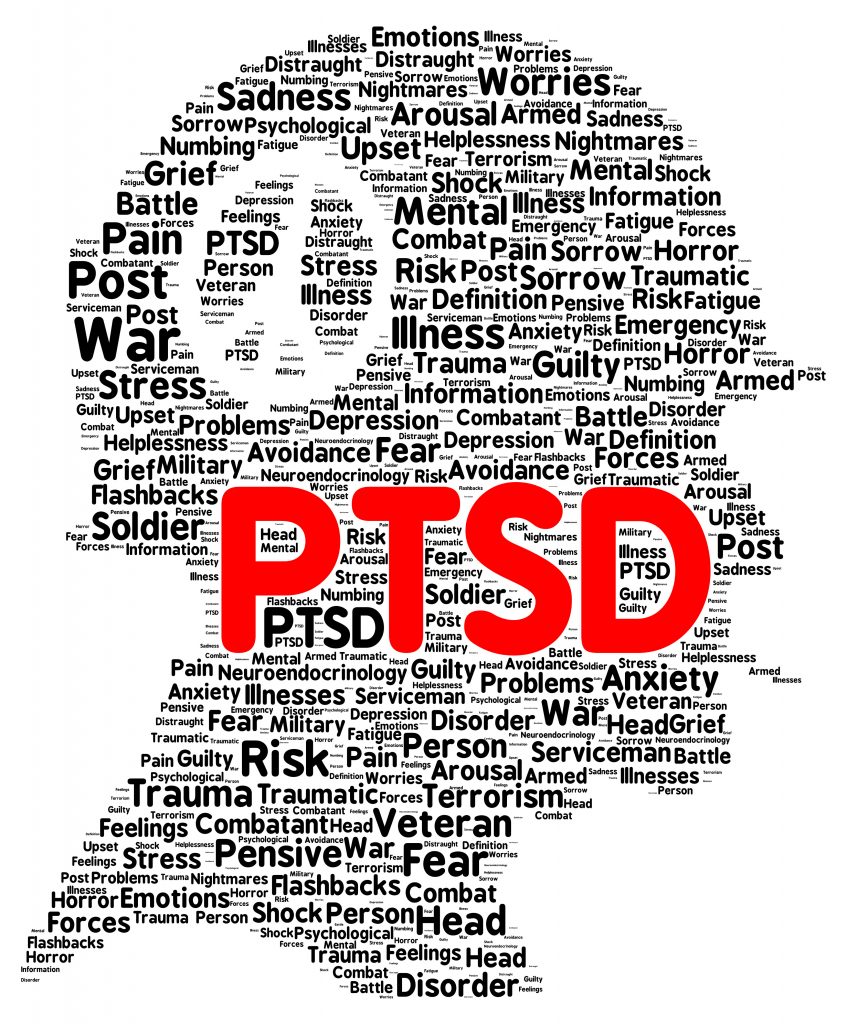
When I think of PTSD, I immediately think of war veterans and how they face PTSD when they come home from the war. The flashbacks, the nightmares, and the distress one faces is traumatic and is hard to overcome. Memory is apart of PTSD, as people recall events and they go in and out of their stream of consciousness. My knowledge about what the war veterans go through has increasingly grew because of the readings and discussions I’ve had in my ASTU class.

A couple weeks ago, in ASTU class, we were assigned to read a short story “Big Two Hearted River” written by Ernest Hemingway. When I read the short story, my initial reaction to the character, Nick Adams was that he was very odd and very interested in nature. It later all made sense, once I was told that Nick came back from the war, which explained his unique behaviour. Hemingway has an interesting writing style as he wants the reader to engage in the book by finding the meaningful information which is not presented clearly in the story. This is the theory of omission, where the most important thing in literature should be omitted and not written. As a reader, that makes you frustrated but also curious forming many observations. As the reader we grasp the latent content, but the manifest content is where we have to think and find the hidden messages. To me, it kind of sounds like the game of hide and seek, but in literature. The story is very descriptive and has this feeling of tension as if something is about to happen, but nothing happens.
This short story shows how Nick is living his life by not talking about his life after the war, but projecting it through nature and objects. The river is an analog for a constantly relaxed consciousness which relates to his mind constantly experiencing new things. The water constantly flows, and so does his model of thinking. Nick is seen to be very repetitive, which is seen when he comes in contact with blackened grasshoppers which resembles traumatized soldiers. Hemingway provides a pathway for us to see the things Nick is not thinking of which I find very interesting. In his mind, Nick has anxiety over these grasshoppers as the natural beings have been affected which relates to soldiers being affected by the war. I believe that the swamp is the dark place in his mind where all the repressed emotions are lying in his mind. The swamp is unlike the river, the water is still, and the components in the swamp are not clear. When he is faced with the swamp, he feels this anxiety and needs to get away from the trauma.
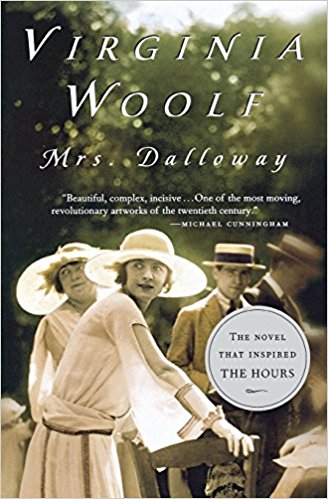
A war veteran projecting his repressed emotions on objects was also seen in the book, Mrs. Dalloway by Virginia Woolf. Throughout the book, we receive many perspectives through different characters whether their the main character or a side character. This provides us with an insight with many opinions on situations, however I found it to be a bit hard to follow. Honestly, I didn’t like the book, although I did like how Woolf chose the style of different narrators, because that gave the reader a closer connection towards the various characters.
The character Septimus Warren Smith, is a war veteran who served in World War I and faces PTSD, which is evident throughout the book. He specifically suffers from shell shock and this causes him to have repetition compulsions. Some characters from the book, comment on Septimus’s behaviour and seem not to understand it and define it as odd. Suffering from shell shock, Septimus is seen to have moral failure as when he dies, Dr.Homes yells “that coward.” The failure of masculinity is seen as he gives up on his wife who loved and cared for him. Septimus suffers from hallucinations of his dead friend Evans. I am not a psychologist, but I believe the reason behind Septimus having these repressed emotions about Evans is due to him not confronting these emotions when he heard Evans died. These emotions are coming back to him through PTSD, and are constantly going through his mind. Septimus remembering memories of the past contrasts with the other characters remembering memories, due his memories causing harm to himself.
Unlike Nick Adams, Septimus openly talks about these repetitive compulsions and emotions which creates this bubble for him. On the other hand Nick, tries to not think about these emotions out loud but thinks of them internally. Septimus and Nick are both alike by projecting on nature. Septimus projects on trees and words like ‘time’, whereas Nick projects on grasshoppers, trout, the river, and the tent. Nick and Septimus have this nature versus war sensations which is embedded in their model of the mind. I find it very intriguing that Nick and Septimus can have these moments where they can look at an object and flash into another ‘reality’ and it become so real to them. They can looks at objects and their mind instantly transports into another dimension of thinking. They have these flights, where they have these compulsions and then they go back to perches, where they come back to reality. Both characters have these overloading sensations, however Septimus’s sensations (spoiler alert) sends him to his death bed. Septimus chooses to keep these sensations which is embedded in his soul and makes the choice to commit suicide. I believe that in Mrs. Dalloway, the doctor was trying to hide Septimus due to his PTSD as it was seen as a threat to society, so the treatment of being sent away was seen as fit. I think it would be interesting if these two characters met and had conversations about what they experience. Nick could actually talk about these expressed emotions out loud and Septimus would have someone who he can relate to and would not feel alone.
I am me, not them
The word identity can be made up of who you think you are and who people portray you as. The difficult part is constructing between the two aspects and creating an identity for yourself. One thing I’ve learned is that your identity can change and is never set in stone. My identity has changed due to my perspectives changing about the world. Identity and culture are two aspects that coincide with one another. I can’t speak for all, but I believe that most people’s identities have culture embedded in them. Culture is such a strong aspect but it can be ignored and put aside when it comes to someone’s identity.
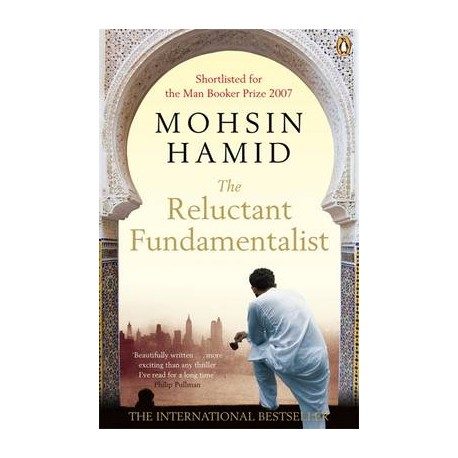
Recently in my ASTU class, we were assigned to read the novel “The Reluctant Fundamentalist” by Mohsin Hamid. The novel portrays the story of a Pakistani man named Changez, telling his story about his time in America to an unnamed American stranger at a cafe in Lahore. Throughout the novel, we see Changez’s love for his friend Erica, his work life at Underwood Samson and his particularly see his identity crisis in his time in the US.
As I read the novel, my first thought was why would Changez tell his story to a stranger? However, as I read on, I realized that I had to look back at their first interaction with one another to understand why Changez acted the way he acted. I sensed that Changez told his story to the unnamed American to show him that not all people who are assumed to be Muslims are harmful. In my honest opinion, I was very intrigued in the beginning as I wanted to know Changez’s experience in the US. However, near the end of the book I was expecting a better ending as I wasn’t too impressed on how the book ended. I thought the ending was going to leave on closure, however to my surprise it left me on a cliff hanger which tricks your mind. With this cliff hanger ending, my mind went to many possibilities and questions of what could have happened between Changez and the American? Was the unnamed American really a secret agent sent to kill Changez ? Did Changez know he was secret agent and what was he was planning to do?
I was very intrigued in Changez’s perspective of his identity. The theme of identity was a key aspect in portraying the event of 9/11 and the reason behind why Changez decided to leave the US. Throughout the book, I felt that Changez had identity crisis as at certain times the US felt foreign but then familiar. Right at the start of book, Changez states that he is a “lover of America” ( Hamid,1). Through his time of being in the US, he identified himself as being from New York. He used phrases like “I need it now” towards people who were his senior which was seen like the American thing to do (Hamid,65). His persona changed as he had great pride from studying at Princeton and working at Underwood Samson as an analyst. The identity crisis is seen when he takes a company trip to Manila. His connection to the Filipino driver in the jeepney shows how he can put on this mask of being an American but deep down he is still a guy from Pakistan. The “third world sensibility” cannot be hidden and this makes him see his co-workers as foreign due to their appearance (Hamid,65).
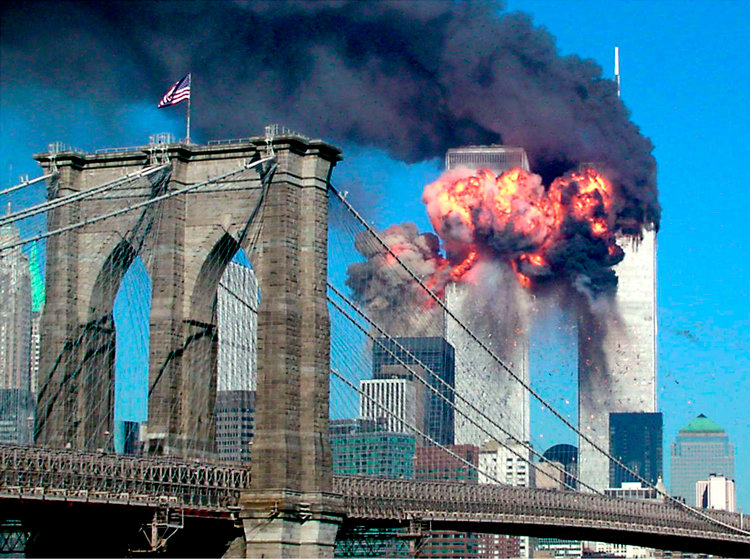
His view of being an American are all blurred when 9/11 happens. This drastic event of 9/11 brings the outcome of fearing a culture and stereotyping. Security checks and frightened stares from passengers, made Changez feel “uncomfortable in [his] own face” when coming back to New York from Manila (Hamid,74). This represents the culture of fear as people have associated people who look Muslim with the word terrorism. I believe at that moment, Changez didn’t see himself as an American he portrayed himself to be, but saw himself as a Pakistani who was seen guilty. The most intriguing point that I found out was that the character was not Muslim but he was assumed to be one. I believe that one should not make the assumption based on a race that he or she is presumed as a threat.
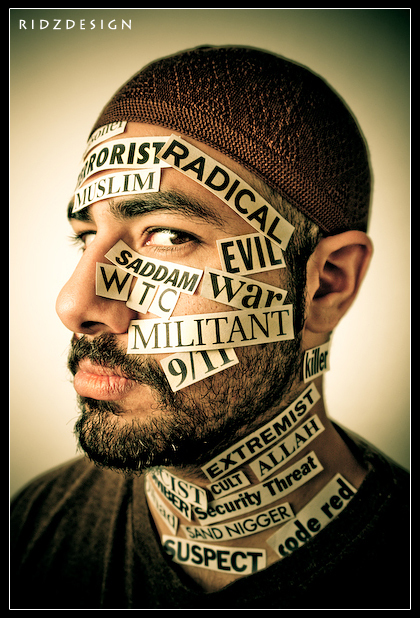
Post 9/11, Changez’s views are altered as he decides to grow his beard amid his friend telling him to get rid of it. His beard symbolized his culture and shows that the connection wasn’t going to fade away. However, his tie to the US doesn’t fade away either as he still has subscription to the Princeton Weekly in Lahore. This attachment shows that Changez’s identity is made up with where he comes from but also the US as he doesn’t want to forget it. His relationship with Erica symbolizes his relationship with the US. He wants it, but can’t have it, and will never stop loving it. Another way of looking at this relationship is seeing how Erica is still drawn to her deceased boyfriend Chris, who is American. Her relationship with Changez goes through troubles which can be seen as cultural as her heart was still with he American. In a sense, it can be seen that Americans only choose Americans and the ties with people like Changez can be seen as complicated and insufficient.
It’s not just a story, it’s history
 One’s perception of a comic book could include having superheroes, drama, comedy and various amounts of action involved. I believe that most people think about comic books in this way, which is what I initially thought as well. I believed that comic books were for entertainment through small stories about how superheroes save the day. I also found comic books to have drama and comedy as I read Archie comics when I was younger. My perception about comic books changed when I read an intriguing graphic narrative in my ASTU class.
One’s perception of a comic book could include having superheroes, drama, comedy and various amounts of action involved. I believe that most people think about comic books in this way, which is what I initially thought as well. I believed that comic books were for entertainment through small stories about how superheroes save the day. I also found comic books to have drama and comedy as I read Archie comics when I was younger. My perception about comic books changed when I read an intriguing graphic narrative in my ASTU class.

We were assigned a graphic narrative called Persepolis by Marjane Satrapi, who is an Iranian-born French graphic novelist. Persepolis pictures the authors story through a girl named Marji. Throughout the book, we see Marji grow up in Iran during the Islamic Revolution and her life after the Revolution as well. We get an inside glance as to how the education system, religion, gender, and the state shapes society and especially Satrapi’s.
As I began reading the book, I was confused as to why I was reading about history in my ASTU class? However, as I read on, I was so intrigued by Satrapi’s story about her childhood in Iran. By the end of the book, I was fascinated with her story, but realized it’s not just a story, but in fact history. The struggles Marjane faced, happened to many other people in Iran who faced similar situations. I found it very interesting on how Satrapi used panels and tiers in the book. Panels is one box surrounded by a border and a tier is a row of panels. I found that when she used big panels, it was seen as a very significant situation or an event. The significance and the representation of religion in Persepolis fascinated me on how it connects with identity.

The theme of religion in Persepolis has been put in the negative and positive spotlight throughout the book. The Muslim religion is seen as strict with harsh punishments if you don’t comply. The rules include a strict dress code and limiting women’s right with concealing their identity. The theme of religion confuses and bring the truth about the world in Marjane’s vision. In the beginning of the book, Marji had this strong connection with God and had the vision of being a prophet. This vision of being a prophet was a part of Marji’s hidden identity, as she didn’t want anyone to know. Some of Marji’s rules were not to have old people suffer, maids eating at the table, everyone having a car, and celebrating traditional Zarathustrian holidays like a fire ceremony. Having these talks with God who was portrayed as an old white man with a beard, gave Marji encouragement that she could become a prophet and improve the world. This thought of being a prophet lost connection as Marji faced the struggles of the Islamic Revolution. She was facing the reality of history and she was hearing the struggles of those closest to her. The history of Iran was conflicting with her identity as she envisioned a perspective of how the world actually was. During these troubled times, Marji found the comfort and safety in God and at times she also demonstrated her anger at God.

Her faith in God demolished when her uncle Anoosh was executed by the Islamic Fundamentalists. She had a close bong with her uncle as he was her hero, and he took upon her as his child. Marji felt lost as her mighty God didn’t save her uncle, and also the world wasn’t full of justice and love. The use of black in the panels signified darkness and her loneliness within the world, and her understanding of it. Marji being surrounded by the planets and stars symbolized how she felt like she was in another world. Having the one panel on the right page signified that this was a crucial moment in Marjane’s life.

At first Marji, believed she was very religious, but saw herself and her parents to be very modern. After her break through with God, Marji adapted to a westernized way which was seen as forbidden in the eyes of the Islamic Fundamentalists. The Fundamentalist viewed anything that was seen as Western to be forbidden, due to their religious rules and act of behaviour. The author displayed how her family included these westernized items in their household like alcohol and a deck of cards but hid it from the outside. In the picture above, Marji had Nike shoes, a denim jacket, jeans, posters, and a Michael Jackson pin which were all forbidden. Marji displayed them anyway as it represented her identity. This displays how she defied her religion and represented it in the negative light. However, she shows another side of her identity by wearing the veil. The veil is very significant as it is part of her religion and her identity. She is holding the fundamentalist regime and her own western identity together which she portrays to be her true self.

The picture above shows the first page of Persepolis and the sense of identity of the veil. Satrapi showed how wearing the veil, shields one’s individual identity as they are all portrayed in the same way. However, it is shown that on the children’s faces they show sadness, confusion, dismay, and irritation which the veil can’t hide. By Satrapi cropping herself from the class photo on the second panel, she signified how everyone had the same identity regardless if she was in the photo. Satrapi might have also cropped herself out by rebelling against the veil and not wanting to be a part of it. The state saw the veil as every women’s identity and how it represented their common culture, but in Persepolis it was represented as suppression and constraint. However, the people in Iran use religion to get away with execution and rape as it is punishment for not wearing the veil and following the strict rules.
In the view of a sociological perspective, Durkheim’s view on religion and society is based upon how religion serves as a function and binds individuals to their fellow citizens. They feel a sense of obligation. Comparing this with Persepolis, I find it to be untrue as Iranians are either for or against the take on their religion. However, the females wearing the veils have commonality with each other. They might not share a common faith, but the veil connects them with each other. Although, the children didn’t feel a sense of obligation in the beginning, as they were confused. They didn’t understand the purpose of wearing the veil so in response they took it off and played with it. As they got older, they had this sense of obligation of wearing it outside of their household as they didn’t want to face the brutal consequences. Sociologically, the sense of “self” is partly being a constructed though religion through the dress code and their beliefs of the system.
Persepolis reveals to us what history looked like through the choice of a comic which views the darkness and light of one’s self. I believe that Satrapi’s purpose of showing us this view on religion is to make us aware on how it can shape our identity and create internal conflict by a sense of religious obligation. This book has made me change my perspective on the purpose of comic books and how religion connects with history. This book being told from a child’s perspective show us the inner take on how children in Iran felt at the time and how their childhoods were very different from ours. Religion can seem to have a positive and negative effect towards identify as it can conceal our identify and help one face the truth of one’s country’s history. I wonder what would happen if Satrapi didn’t truly believe in God in the beginning and how it would have affected her story?
https://medium.com/@camillaanderson/exploring-the-significance-of-the-veil-in-marjane-satrapis-persepolis-416886a817e4
The “truth” through one’s lens
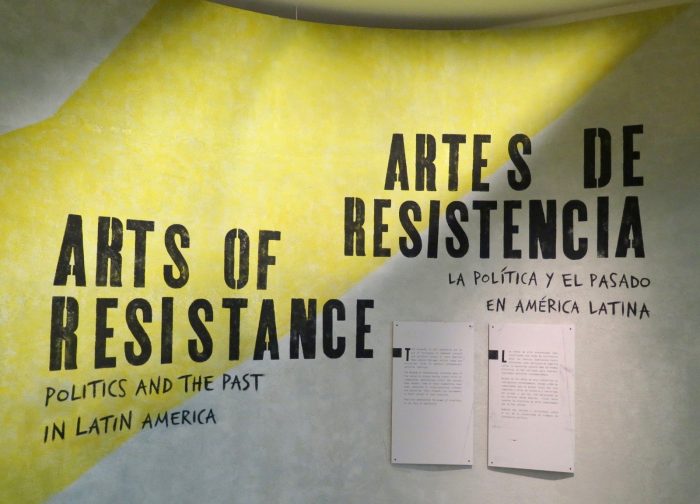
The Museum of Anthropology at UBC is designed to tell us stories through objects of history. In the Museum, I had the chance to see an interesting exhibition called the “Arts of Resistance: Politics and the Past in Latin America, ” which was curated by Dr. Laura Osorio Sunnucks. This exhibition was designed to give everyone an inside look into how “traditional or historical arts forms” can be used to express political and social struggles people have faced and are facing in marginalized communities. This exhibition shows global arts and performance of artists from Mexico, Peru, Guatemala, El Salvador, Ecuador, and Chile.
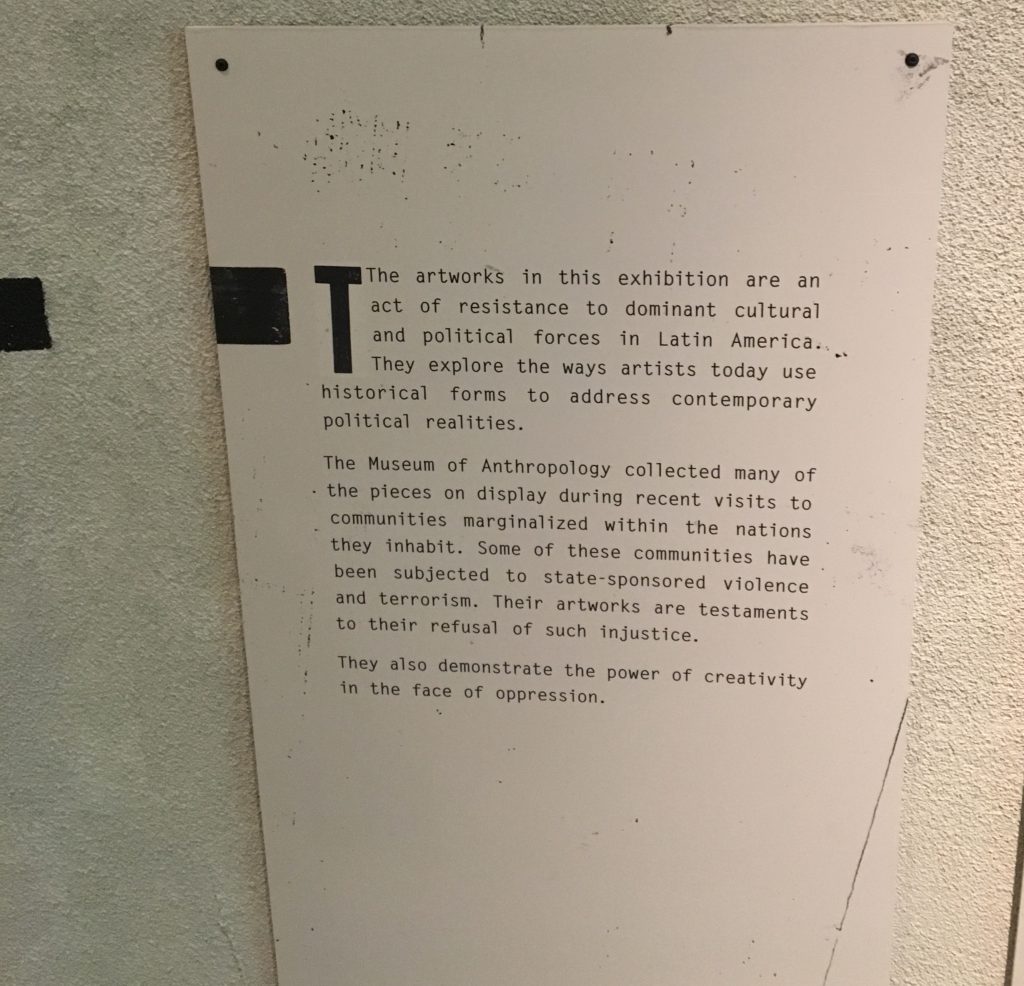
I have been to museums a couple of times during my childhood, and I did not fully understand the stories behind the art. I saw the art but could not comprehend what the artists were trying to convey. As I have now matured, I now understand and can analyze the performance of art and see the hidden stories behind them. I believe that looking at art and searching for the hidden stories takes effort and is time consuming. The reason why everyone is so silent and fixated on the art is that they are trying to find the story. I have recently found this out when I visited the Arts of Resistance exhibition. The first time I went to see this exhibit, I was a bit lost and didn’t understand what the artists were trying to convey. I simply walked in, looked at the art and then left with a very confused mind. I spent about 20 minutes looking at the art and nodding my head thinking I understood what was around me, but simply I did not. I wanted to have a better understanding of the exhibition, and this enticed me to visit the exhibition for the second time. As I revisited the exhibition, I had a greater sense to really engage in the art and I was driven to find the stories in the different pieces of art. I took the time to really engage in the artwork and finally understood the stories of the objects around me. I found that all the pieces and performances in the exhibit drew to the theme of memory which was discussed in my ASTU class.
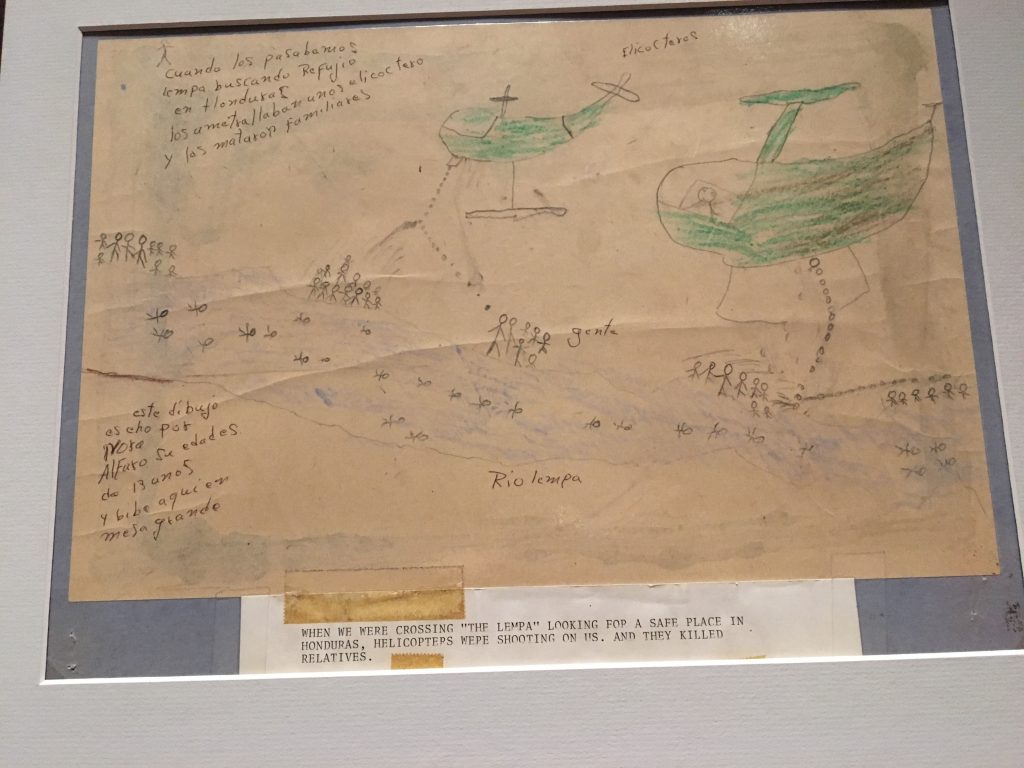
As I walked around the exhibit, the one object that really struck me, and shocked me was an art drawn from a child. In the art, it is shown the green helicopters who were the Salvadoran military were shooting on the Salvadoran refugees, as they were only trying to find a home in the Houndras by crossing the River Lempa. In the artwork, there appears to be around 70 people trying to escape in search for safety. Some refugees are seen in groups trying to escape and getting shot at. Whereas, other refugees are seen swimming in the water trying to escape from gun shots and reach safety.
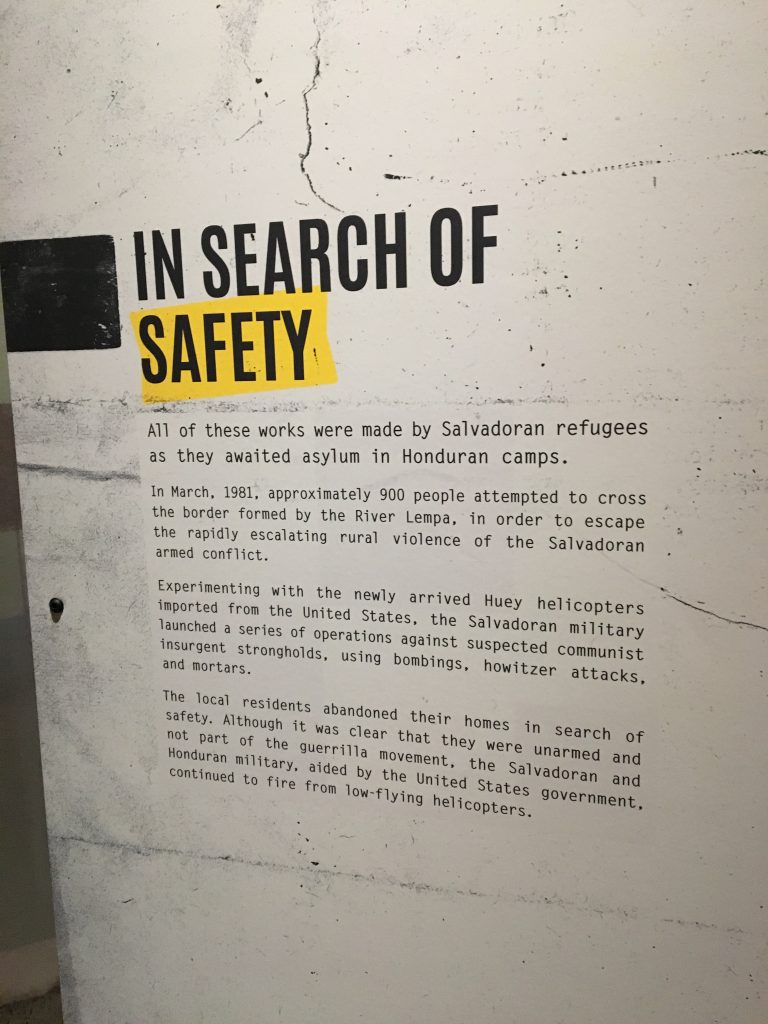
The child’s memory of the event was one version of the truth. In his/her eyes, I saw what he/she saw and experienced. This made me realize that we all have different childhoods and those memories can stick with us forever. This makes a global connection towards the different stories and experiences everyone has. During those times, someone’s childhood was based on experiencing the act of violence and loss of family and relatives. Whereas, in another part of the world, someone’s childhood was filled with laughter, fun, and joy.
In my ASTU class, we talked about questions like “can this individual memory tie with the collective memory and how it affects the memory of the group ?” This got me wondering if this child’s memory is presumed as the sole “truth?” Also, can this individual memory tie with the collective memory of all the children refugees at the time?” The documemoir, “Stories We Tell,” by Sarah Polley shows the different perceptions of truth told by Sarah’s family members and friends which tries to unveil Sarah’s identity. The film highlights how memory affects how people tell their stories. The art above, is one perception of the truth and unveils a certain piece of the Salvadoran refugees’ identities. The art was drawn out of memory of violence and how that can twist the truth by exaggerating or underestimating the violence to better oneself. Violence in a child’s memory can be totally different from an adult’s mind. The explosions and the gun shots may sound more alarming and tremendous. Underestimating the situation and filtering out the violent part of the memory might happen to better the child’s childhood. The child’s memory of what happened when everyone was trying to escape can be different from another child’s perspective as well. As the audience, we have to interpret the truth from the art.
In the view of a sociological perspective, this artwork connects with the idea of the sociological imagination. The sociological imagination shapes our experiences using external factors. This connects a link between personal troubles and public issues. An example of personal troubles can be discrimination in the workplace which is a huge public issue now days. This personal trouble of experiencing trauma and violence can make people connect with others who have experienced this as well. This makes refugees see that others have experienced the same and that it is not a personal trouble but a public issue. However, a child might not have this sociological imagination by connecting with others through this experience because it is unsettling and very traumatic. Also, the time to reflect on the situation and talk to others is minimal due to the constant worry of finding safety. This made me think about how refugees might not have the time to reflect back on their experience as they might be worried about their safety and wellbeing.
This exhibition was an eye opener for me about the world around me, and how everyone’s experiences are so unique. I realized that memory plays a very important role in recalling the past and how it can be and not be the truth. At first, I was really confused about the exhibit, but after my second visit, I truly connected with some of the pieces of art. The child’s artwork was really outstanding, and it made me understand that not everyone has a great childhood. I felt very distraught and emotional thinking about what children had to truly experience in their early years of childhood. I still wonder, in the exhibition, how does the memories of the people affect the work of the artist? How does the artists take the truth and the memory to really paint the picture?
https://creatorsvancouver.com/latin-american-resistance-art/
Hello world!
Welcome to UBC Blogs. This is your first post. Edit or delete it, then start blogging!